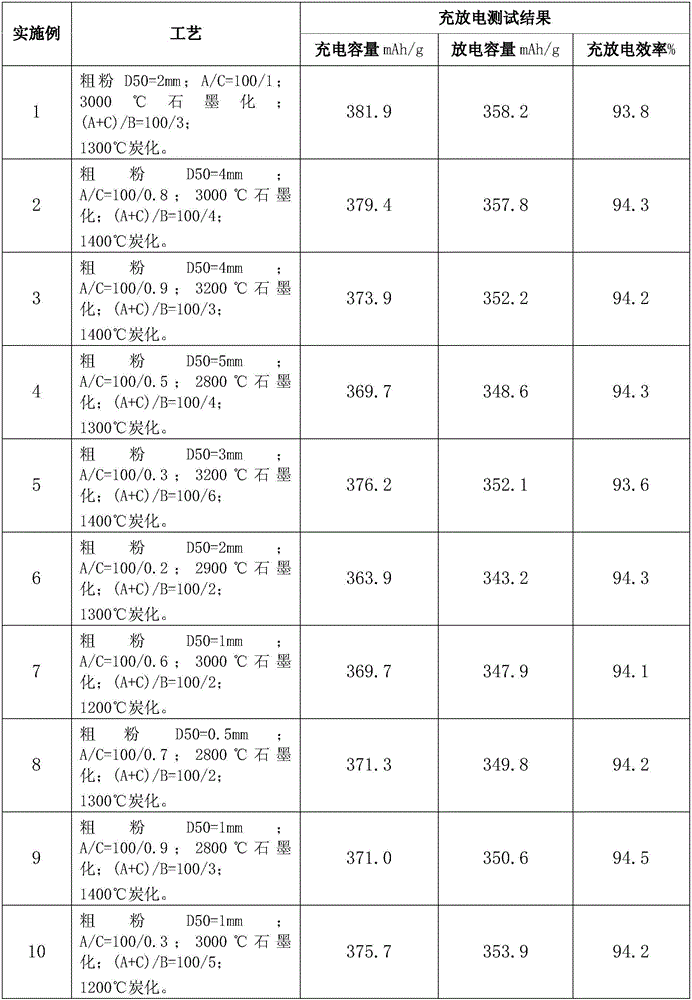A kind of production method of high-capacity lithium-ion battery artificial graphite negative electrode material
An artificial graphite negative electrode, lithium ion battery technology, applied in battery electrodes, batteries, secondary batteries and other directions, can solve the problems of poor cycle, loss of capacity, low yield, etc., to achieve high production efficiency, reduce the degree of oxidation, reduce the ratio of The effect of surface area
- Summary
- Abstract
- Description
- Claims
- Application Information
AI Technical Summary
Problems solved by technology
Method used
Image
Examples
Embodiment 1
[0021] Weigh 100 kg of petroleum coke raw material A after forging, and pulverize it into coarse powder with a particle diameter of about 2 mm.
[0022] Weigh 5 kg of asphalt raw material B, and perform jet milling, and the crushed particle size is ≤3 μm.
[0023] Weigh 60 kg of crushed raw material A coarse powder, add 600 g of raw material C fine powder, stir and mix at room temperature for 30 minutes, and then graphitize at 3000° C.
[0024] Weigh 50 kg of the graphitized mixed material, finely pulverize and classify, the median particle size of the class is 18 μm, and then carry out mechanical shaping for 30 min.
[0025] Weigh 20kg of the reshaped mixed material, add 600g of raw material B micropowder, mix at room temperature for 30min, then modify at 300-600°C, and then carbonize at 1300°C.
[0026] After the carbonized material is cooled to room temperature, it is dispersed, screened, and impurity removed to obtain the product.
[0027] A LIR2430 type button battery w...
Embodiment 2
[0029] Weigh 100 kg of petroleum coke raw material A after forging, and grind it into a coarse powder with a particle diameter of about 4 mm.
[0030] Weigh 5 kg of asphalt raw material B, and perform jet milling, and the crushed particle size is ≤3 μm.
[0031] Weigh 60 kg of crushed raw material A, add 480 g of raw material C, stir and mix at room temperature for 30 minutes, and then graphitize at 3000°C.
[0032] Weigh 50 kg of the graphitized mixed material, finely pulverize and classify, the median particle size of the class is 17 μm, and then carry out mechanical shaping for 30 min.
[0033] Weigh 20kg of the reshaped mixed material, add 800g of raw material B micropowder, mix at room temperature for 30min, then modify at 300-600°C, and then carbonize at 1400°C.
[0034] After the carbonized material is cooled to room temperature, it is dispersed, screened, and impurity removed to obtain the product.
[0035] A LIR2430 type button battery was used for the test, and the...
Embodiment 3
[0037] Weigh 100 kg of needle-shaped petroleum coke raw material A, and pulverize it into a coarse powder with a particle diameter of about 4 mm.
[0038] Weigh 5 kg of asphalt raw material B, and perform jet milling, and the crushed particle size is ≤3 μm.
[0039] Weigh 60 kg of crushed raw material A, add 540 g of raw material C, stir and mix at room temperature for 30 minutes, and then graphitize at 3200°C.
[0040] Weigh 50 kg of the graphitized mixed material, finely pulverize and classify, the median particle size of the class is 15 μm, and then carry out mechanical shaping for 30 min.
[0041] Weigh 20kg of the reshaped mixed material, add 600g of raw material B micropowder, mix at room temperature for 30min, then modify at 300-600°C, and then carbonize at 1400°C.
[0042] After the carbonized material is cooled to room temperature, it is dispersed, screened, and impurity removed to obtain the product.
[0043] A LIR2430 type button battery was used for the test, and...
PUM
| Property | Measurement | Unit |
|---|---|---|
| particle diameter | aaaaa | aaaaa |
| particle diameter | aaaaa | aaaaa |
| particle diameter | aaaaa | aaaaa |
Abstract
Description
Claims
Application Information
 Login to View More
Login to View More - R&D
- Intellectual Property
- Life Sciences
- Materials
- Tech Scout
- Unparalleled Data Quality
- Higher Quality Content
- 60% Fewer Hallucinations
Browse by: Latest US Patents, China's latest patents, Technical Efficacy Thesaurus, Application Domain, Technology Topic, Popular Technical Reports.
© 2025 PatSnap. All rights reserved.Legal|Privacy policy|Modern Slavery Act Transparency Statement|Sitemap|About US| Contact US: help@patsnap.com

